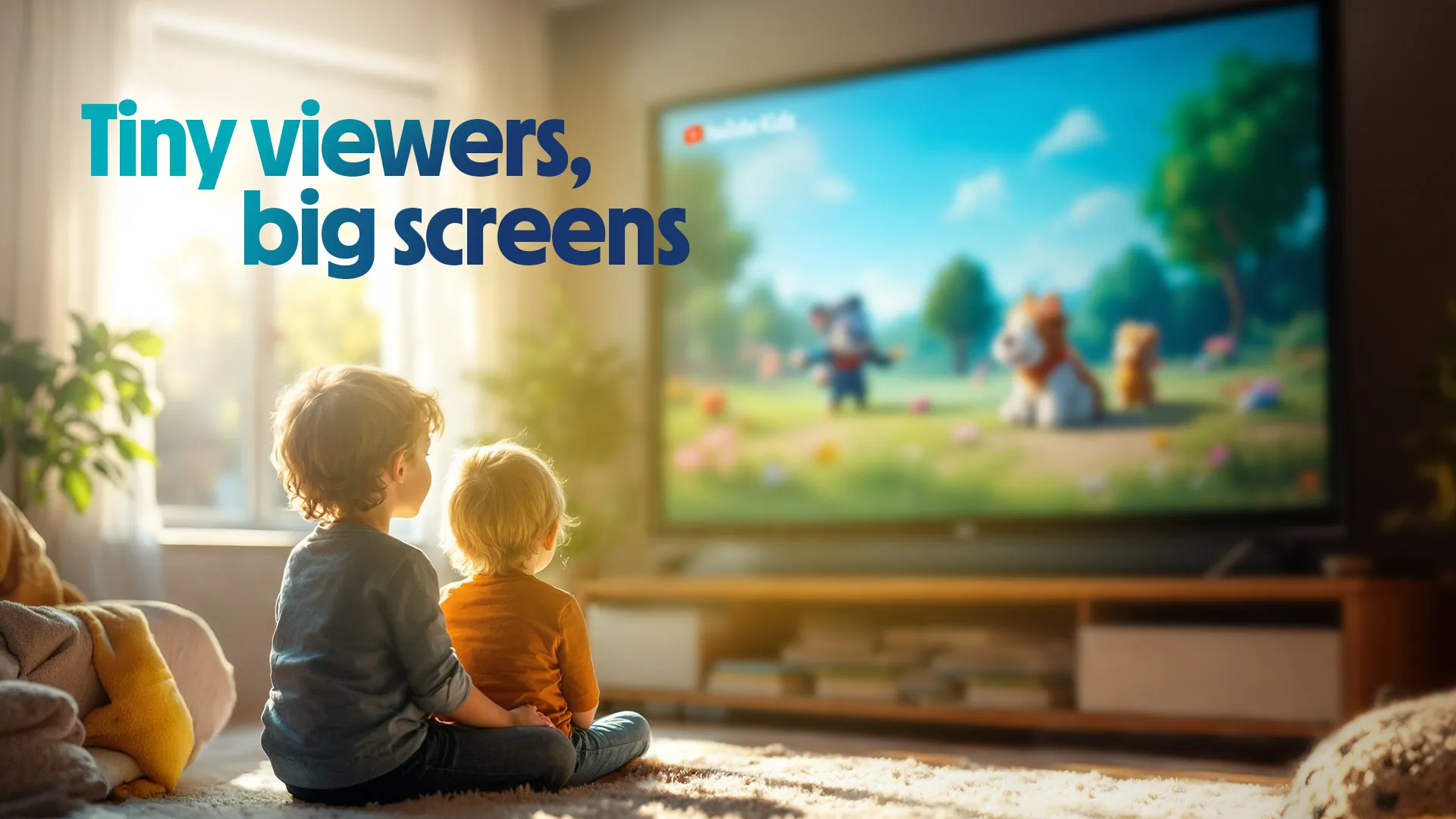What YouTube Viewership on TV Screens Really Looks Like - And Why It Matters Here in NZ

In a media landscape where screens and platforms are increasingly interconnected, it’s more important than ever to understand what audiences are actually watching - not just where.

What YouTube Viewership on TV Screens Really Looks Like - And Why It Matters Here in NZ
There’s been a lot of conversation lately about YouTube’s growing presence on the biggest screen in the house - but what does that really look like?
New UK data offers a fresh lens on YouTube viewing via connected TVs, challenging some common assumptions about scale, frequency, and context. While this is UK-based research, it raises important questions for broadcasters and advertisers here in New Zealand - particularly as viewing habits continue to shift.
In this piece, Justin Lebbon from The Future of TV breaks down the findings - and why they’re worth paying attention to, wherever you are.
👇 Read the full article below. Published with permission
Barb data has delivered the TV industry a new narrative about UK YouTube audiences. Will it change advertiser behaviour?
Barb’s long-anticipated data measuring the “most-watched” 200 YouTube channels in the UK, designed to provide context against how TV is traditionally measured for currency, is finally out.
Everyone — consumers, media buyers, and small businesses — relies on YouTube to some extent. It’s an incredible tool, and could be so much more with greater insights and transparency.
In my view, the latest effort stems from Google’s decision to call YouTube “TV.” That prompted Barb, as a joint-industry currency (JIC), to level the playing field.
There’s still debate among buyers about whether YouTube is truly “TV,” how it should be measured and whether Google should engage with trusted industry JICs.
So, what’s in Barb’s data?
The standout stat for me: a small fraction of all YouTube viewing comes from the top 200 channels. That begs the question: what exactly are people watching on YouTube? Clearly, it’s the long tail that drives the vast majority of viewership on the platform.
Kids’ content dominates TV-set YouTube viewing
Barb’s data show that kids—particularly very young children—are the biggest drivers of YouTube viewing on TV sets in the UK.
The JIC publicly revealed the top 20 channels it’s tracking, with the other 180 behind a paywall. Looking at TV-set viewing, 15 of the top 20 channels are kids’ content—and I mean little kids.
Parents are clearly using YouTube on the TV to occupy toddlers while cooking, cleaning, or taking a break. As a father of four, I can confirm: I’ve been there.

Nearly all these channels are aimed at 18 months to five years old — not the best advertising demo. Yes, you could argue parents are in the room, but that’s a stretch. Most of the content is intolerable for adults—bearable only because it pacifies intolerable toddlers.
I’ve worked on and seen projects with major brands questioning where their YouTube ads actually ran. Often, they discover heavy exposure to kids’ content. This data confirms what clients long suspected but couldn’t prove.
More informed strategies needed
We often forget why TV advertising is so powerful and hard to replicate. It’s because you can get huge reach instantly in shared environments. That reach drives footfall for the week, tomorrow’s sales, and the kind of cultural impact advertisers dream of. This is why the Super Bowl remains so impactful.
Looking at Barb’s data, it’s very difficult — if not impossible — for planners to achieve that level of reach and impact via YouTube alone. It’s a reminder that buyers should approach YouTube with a more informed strategy.
Jonathan Waite, EVP and global head of planning at Havas Media Network, summed it up: “Barb’s work is a welcome step toward demystifying YouTube’s role in the video ecosystem. The data reinforces what many in the industry have long suspected: that YouTube’s viewing is highly fragmented and driven by the long tail, not marquee channels.
“This kind of transparency is essential if we’re to make informed decisions about where and how to invest.”
It’s no coincidence that Barb has released this data while Google has decided to step back from supporting Barb in any meaningful way. One could infer this was the straw that broke the camel’s back, but what are they worried about? Much of this data confirms what buyers already suspected.
“I don’t really think YouTube wants to ‘be TV,’ but it certainly wants the budgets it believes its audience scale should command,” Waite added.
“If YouTube wants to compete for TV budgets, it must be willing to be measured by TV standards. The fact that Google stepped away from supporting Barb [before] this release is disappointing—it suggests a reluctance to embrace the kind of accountability that would benefit the entire ecosystem.”
Despite this, it’s no secret that YouTube is chasing TV budgets, and you can’t blame broadcasters for supplying data to protect their share. Opinions are split on whether the strategy is working. Anecdotally, some clients are shifting spend from TV to YouTube, but when I speak to data and spend experts, they haven’t seen a major change.
My take: the narrative is having some impact, but it’s not huge — yet.
Kelly Williams, commercial MD for ITV, said he supported the move toward greater transparency and Barb’s role in setting a standard across different video assets.
“Barb is strategically extending its industry-standard measurement to encompass VOD streamers and video-sharing platforms alongside TV,” he said. “While this initial release covers 200 YouTube channels—just 0.3% of total viewing—it marks a significant first step. Independent, transparent measurement of YouTube content is long overdue and should be welcomed by advertisers, broadcasters, and regulators alike.”
Global hype vs local reality
YouTube loves to quote big global numbers, but they’re meaningless until broken down. Google isn’t alone in promoting vanity metrics, but they lead to confused marketers and distorted reality.
Take MrBeast. He’s YouTube royalty, with 400M+ subscribers and appearances at upfronts. But the perception vs reality is stark. In the UK, his channel reaches just 319,000 weekly TV viewers (4+), almost exactly the same as BBC3 Parliament.
This is the classic gap between global hype and local, demo-specific reality. YouTube will keep selling massive global reach, but market-level data tells a different story.
Ross Sergeant, global head of media for Allwyn, made a sharp comparison: “That global reach quote reminds me of when we used to buy CNN global feed in the early 2000s—it was the biggest news channel in the world, but never the biggest in any single market. It just looked great on a PowerPoint.”
However, he criticized Barb’s “top 200 channels” approach as grafting a linear TV mindset onto a platform that doesn’t work that way.
On YouTube, algorithms—not channels—drive discovery. Skipping is rampant, and top 200 data doesn’t capture the real long-tail behavior.
“It’s unfortunate that we only looked at YouTube’s top 200 channels because that seems to be trying to retrofit 1990s linear TV formats to something that isn’t the same, and it simply misses the far more important long tail of viewership.
“Watching channels simply isn’t the way people view content on YouTube. Just like TikTok and Instagram, people’s next video is recommended by the algorithm, or a quick jump back to the search bar, and there is always a large amount of skipping — even when viewed on the TV. I don’t find [a] ‘top 200’ useful at all.
“I think including YouTube data in Barb reports came from the right place, but it hasn’t been enlightening.”
Sergeant views YouTube as social video, not TV. I don’t fully agree with this point of view.
YouTube positions itself as TV, so comparison data is valid — and broadcasters should continue to demonstrate the differences. To claim this data isn’t enlightening is surprising to me, too.
Waite also agrees with this and points out that YouTube isn’t viewed as TV, but that it doesn’t matter: “YouTube is a fundamentally different beast from linear TV. It’s not built around scheduled, shared moments, it’s a sprawling, algorithm-driven universe of micro-communities and niche interests.
“That’s part of its appeal. Its global scale is undeniable, but that scale is distributed across a vast range of content verticals, not concentrated in tentpole programming. In that sense, it’s the opposite of what we traditionally think of as ‘TV.'”
The bigger picture
Social platforms sell themselves on outcomes and KPIs, and many clients are happy as long as results appear. But ignoring where ads actually run is a mistake, in my view.
Media analyst Ian Whittaker, who has spoken on this topic frequently, also weighed in: “Barb’s data suggests a risk for YouTube in trying to be all things to all people.
“Even its biggest stars don’t match TV audiences, and it risks being outmaneuvered on social by TikTok. It may need to choose a lane—and soon.”
Ultimately, YouTube still acts like a social video platform even as it chases TV budgets. Buyers remain divided: they value the new data but also argue YouTube isn’t consumed like TV.
As Waite concluded: “Trying to measure YouTube through a linear lens misses the nuance. Discovery is algorithm-driven, feeds are personalized, and audiences dip in and out. But unlike TikTok, YouTube also has longer-form content and a robust creator economy, making it a hybrid — neither fully TV nor fully social video.”
For now, Barb has given the TV industry a new narrative, with data to back it up. Whether it will change advertiser behavior — well, that’s a different question.




